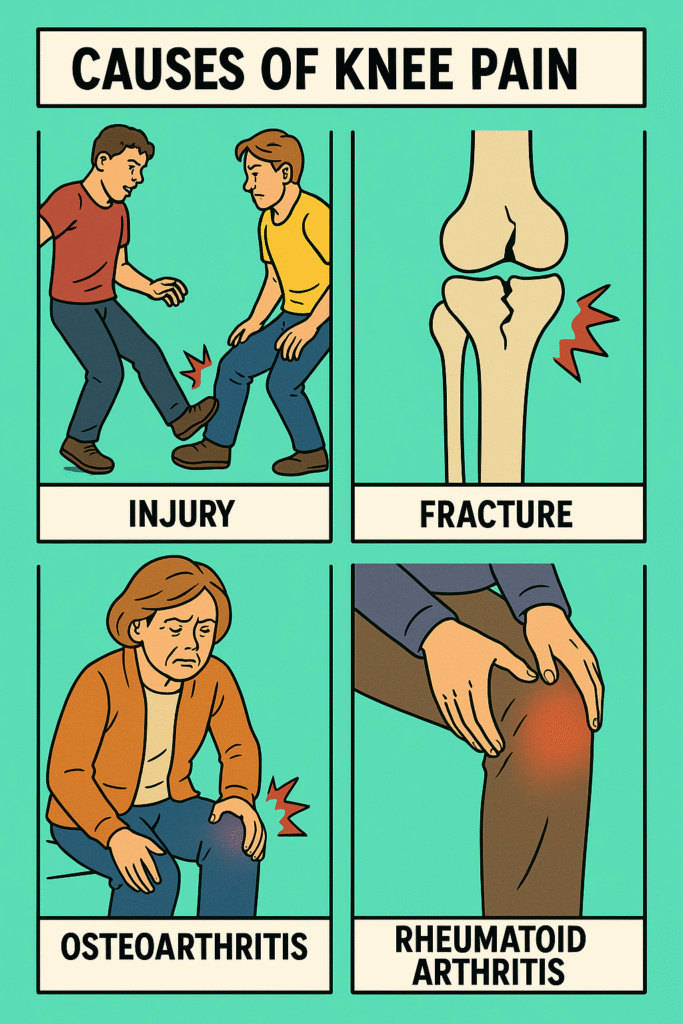Knee pain is something many of us have felt at one point or another. Whether it’s a sharp twinge after a jog, a dull ache that creeps in during cold weather, or swelling after a fall—it’s one of the most common complaints seen in clinics. In fact, knee pain affects people of all ages and is a leading cause of physical disability worldwide.
But what’s behind it? Why does the knee hurt, and how do you figure out what’s wrong? Let’s break it down in simple terms.
What Is Knee Pain?
Knee pain refers to discomfort or soreness in or around the knee joint. It can result from an injury, such as a torn ligament or cartilage, or from medical conditions like arthritis, gout, or infections.
Some quick facts:
- It’s more common in athletes, older adults, and people who are overweight.
- About 25% of adults experience knee pain that limits function.
- The pain might be sharp, dull, throbbing, or come with swelling and stiffness.
How Does It Happen?
Your knee is like a complex hinge made up of bones, cartilage, ligaments, tendons, and fluid-filled sacs called bursae. It carries the weight of your body, absorbs shocks, and helps you walk, run, and jump.
When any part of this system is injured or inflamed, pain happens. Imagine a car suspension system—if one spring or shock absorber fails, the whole ride becomes uncomfortable. That’s your knee when something’s wrong.
Here’s how different structures can cause pain:
- Cartilage damage (like in osteoarthritis) reduces cushioning.
- Torn ligaments from twisting injuries cause instability.
- Inflamed bursae or tendons create sharp pain with movement.
- Misalignment or mechanical imbalance (e.g. flat feet) strains the joint.
What Causes Knee Pain?
Knee pain doesn’t come from just one thing. Here are the common causes:
- Injuries (most common)
- ACL (anterior cruciate ligament) tears – often in sports
- Meniscus tear – from twisting or squatting
- Fractures – due to trauma or osteoporosis
- Dislocations
- Overuse (especially in active people)
- Runner’s knee
- Patellar tendinitis
- Iliotibial band syndrome
- Inflammatory causes
- Osteoarthritis (most common in older adults) – ~40% of people over 70
- Rheumatoid arthritis
- Gout or pseudogout
- Bursitis
- Infections
- Septic arthritis (urgent and dangerous)
- Other causes
- Osgood-Schlatter disease (in teenagers)
- Referred pain from hip or lower back

Risk Factors
Anyone can get knee pain, but some people are more prone to it than others.
Who’s more likely to have it?
- Older adults (especially with arthritis)
- Athletes (especially in high-impact sports)
- People who are overweight (extra weight = more strain on the knee)
- Those with previous knee injuries
- People with poor muscle strength or flexibility
Top Risk Factors:
- Age: Cartilage wears down over time.
- Obesity: Every extra kg adds 3-4 kg of force across the knee.
- Weak muscles: Especially weak quadriceps.
- Occupation or lifestyle: Jobs that involve kneeling, climbing, or heavy lifting.
Other Symptoms to Watch For
Knee pain doesn’t usually come alone. Pay attention to these signs:
- Swelling or stiffness
- Redness or warmth (suggests inflammation or infection)
- Popping or crunching sounds
- Inability to fully straighten or bend the knee
- Instability or feeling of “giving way”
If the pain is severe, the knee looks deformed, or you can’t bear weight—see a doctor right away.
Tests to Identify the Cause
The gold standard test often depends on what your doctor suspects. But usually, the process includes:
- Physical examination – checking movement, strength, and areas of tenderness.
- X-ray – to check for fractures or arthritis.
- MRI – best for soft tissue injuries like ACL, meniscus tears, or cartilage damage.
- Ultrasound – useful for fluid collection or bursitis.
- Joint aspiration (arthrocentesis) – if infection or gout is suspected. A sample of fluid is taken from the knee and examined.
Treatment for Knee Pain
Treating knee pain depends on the cause—but the main goal is to reduce pain and improve function.
Gold Standard Treatment:
- RICE for injuries:
- Rest
- Ice
- Compression
- Elevation
- NSAIDs like ibuprofen to reduce pain and swelling
- Physiotherapy – tailored exercises to strengthen muscles around the knee
- Weight loss – crucial in managing chronic knee pain, especially arthritis
- Bracing or taping – provides support
Other Options:
- Steroid injections for severe inflammation
- Viscosupplementation – hyaluronic acid injections in osteoarthritis
- Surgery – arthroscopy for meniscus tears or ligament repairs; joint replacement for advanced arthritis
- PRP (Platelet-rich plasma) – still under investigation, used in some sports medicine settings
References
- Knee Pain – Causes, Diagnosis & Treatment, Cleveland Clinic, 2023. https://my.clevelandclinic.org/health/symptoms/17696-knee-pain
- Knee pain, Mayo Clinic, 2024. https://www.mayoclinic.org/diseases-conditions/knee-pain/symptoms-causes/syc-20350849
- Osteoarthritis, CDC, 2024. https://www.cdc.gov/arthritis/basics/osteoarthritis.htm
- Meniscus Tear, OrthoInfo by AAOS, 2023. https://orthoinfo.aaos.org/en/diseases–conditions/meniscus-tears
